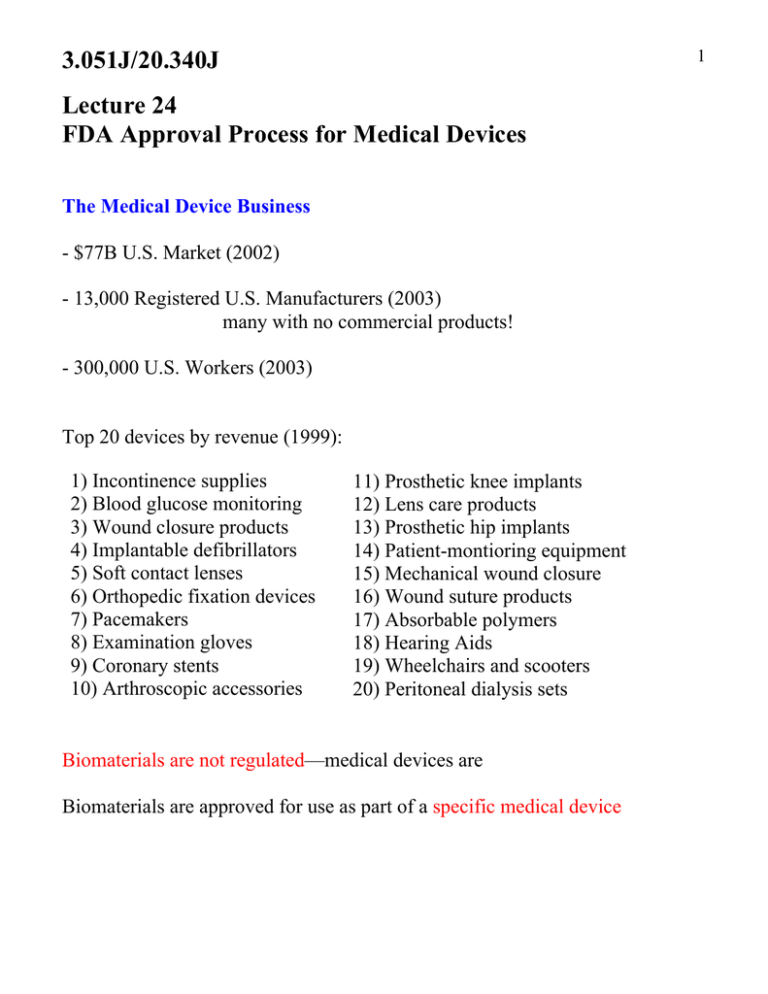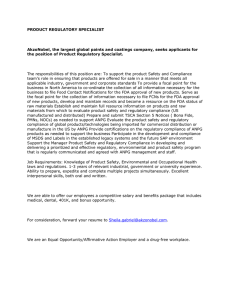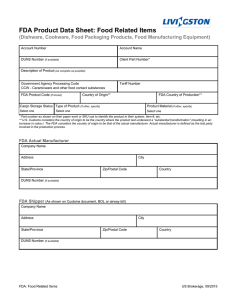3.051J/20.340J Lecture 24 FDA Approval Process for Medical Devices
advertisement

1 3.051J/20.340J Lecture 24 FDA Approval Process for Medical Devices The Medical Device Business - $77B U.S. Market (2002) - 13,000 Registered U.S. Manufacturers (2003) many with no commercial products! - 300,000 U.S. Workers (2003) Top 20 devices by revenue (1999): 1) Incontinence supplies 2) Blood glucose monitoring 3) Wound closure products 4) Implantable defibrillators 5) Soft contact lenses 6) Orthopedic fixation devices 7) Pacemakers 8) Examination gloves 9) Coronary stents 10) Arthroscopic accessories 11) Prosthetic knee implants 12) Lens care products 13) Prosthetic hip implants 14) Patient-montioring equipment 15) Mechanical wound closure 16) Wound suture products 17) Absorbable polymers 18) Hearing Aids 19) Wheelchairs and scooters 20) Peritoneal dialysis sets Biomaterials are not regulated—medical devices are Biomaterials are approved for use as part of a specific medical device 3.051J/2O.340J Regulation History 1906 Food and Drug Act - established the FDA - no provisions on medical devices (regulated by the U.S. Postal Service under postal fraud statutes) 1938 Food, Drug and Cosmetic Act - FDA regulation of device misbranding/adulteration (inadequate authority/resources for wide scale regulation) 1976 Medical Device Amendment Classified Devices & Regulatory Standards for Safety & Efficacy Class I: low risk, general controls sufficient over the counter products-e.g., adhesive bandages, hospital beds Class II: performance standards & general control physician controlled distribution-e.g., oxygen masks, bloodpressure cuffs, powered wheelchairs Class III: require pre-market approval devices that: “support or sustain human life, are of substantial importance in preventing impairment of human health, or which present a potential unreasonable risk of illness or injury” Further regulation by the FDA under: 1990 Safe Medical Devices Act 1992 Medical Device Amendments 1997 FDA Modernization Act (Section 204) 2 3.051J/20.340J FDA Regulatory Branches Center for Device and Radiological Health (CDRH): medical devices Center for Drug Evaluation and Research (CDER): drugs Center for Biologic Evaluation and Research (CBER): biological therapeutics combination products (therapeutic + device) may fall under any of above Premarket Approval Process for Class III Devices Established in: Title 21 Code of Federal Regulations (CFR) Part 814 1. Administrative and limited scientific review - conducted by FDA personnel within 45 days of receipt - determines if application is of sufficient quality for filing - “filing” initiates 180-day review clock 2. In-depth scientific, regulatory and Quality System review - conducted by FDA personnel - includes inspection of manufacturing facility - usually results in a “deficiency letter” voices FDA concerns with an application Major deficiency letter – stops the 180-day clock Minor deficiency letter – 180-day clock continues - applicant has 30 days to respond 3. Advisory panel review 3 3.051J/20.340J - first-of-a-kind devices - 5 outside experts in field of device, + industry & consumer reps. - public hearing on safety & efficacy of device including applicant - Panel makes recommendation to FDA 4. FDA notification - generally concurs with panel - usually 6-18 months after panel decision - outcomes: Approval order – private license granting applicant permission to market device - A PMA may be sold to another company - licensees must submit a PMA application showing substantial equivalence Approvable letter – device substantially meets FD&C Act; specific info. required or conditions for approval e.g., labeling requirements, sale restrictions, post-approval study Not approvable letter – device fails to meet safety and efficacy std. - applicant may amend PMA - file petition for reconsideration - withdraw the PMA (default) PMA Review Fees Established by: Medical Device User Fee and Modernization Act 2002 Standard fee (2006): $259,600. Small Businesses (gross sales < $100M): $98,648. Fees waived for 1st time applicants with sales < $30M 4 3.051J/20.340J 5 What Goes into the PMA Application? 1. Applicant name & address 2. Table of Contents 3. Summary 4. Device Description including components, composition, principles of operation, methods of manufacture, packaging, storage, and use 5. Reference to performance or voluntary standards American Society for Testing and Materials (ASTM) standards compositions, mechanical testing, corrosion testing, device standards Association for the Advancement of Medical Instrumentation device standards, procedure standards (e.g., sterilization processes) International Standards Organization (ISO) 10993 guidelines biocompatibility tests Applicant demonstration of how device meets standards 6. Technical data on safety and efficacy - Non-clinical laboratory studies: biocompatibility, stress, wear, shelf-life - Clinical studies 7. Justification if single-investigator study 8. Bibliography of all related published reports with synopsis 9. Samples of the device 10. Proposed labeling of the device 11. Environmental assessment of device 12. Financial certification and disclosure statement 13. Other information requested by the FDA 3.051J/20.340J What Biocompatibility Testing is Required? Recommended tests depend on the category of device I. Non-contact devices II. External contact devices A. Intact surfaces: contact with external body surfaces only e.g., electrodes, external prostheses, monitors B. Breached or compromised surfaces e.g., burn dressings, wound-healing devices, occlusive patches III. Externally communicating devices A. Intact natural channels e.g., contact lenses, urinary catheters, colonoscopes B. Blood path, indirect: conduit for fluid entry to vasculature e.g., solution and blood administration sets C. Blood path, direct: contact circulating blood e.g., IV catheters, dialyzers and tubing, oxygenators and tubing IV. Internal devices A. Bone e.g., orthopedic plates & pins, bone prostheses, cements B. Tissue and tissue fluid (incl. prolonged mucous membrane) e.g., pacemakers, drug delivery devices, breast implants, IUDs C. Blood e.g., pacemaker electrodes, vascular grafts, heart valves 6 7 3.051J/20.340J FDA Biocompatibility Test Matrix II FDA Recommended Testing (1995) A III B A B IV C A B C Irritation tests X X X X X X X X Sensitization assay X X X X X X X X Cytotoxicity X X X X X X X X Acute systemic toxicity Hemocompatibility X* X X X X X X X X X X X X X X X X X X X X Pyrogenicity Implantation tests X* X X X X X X Mutagenicity X* X*+ X X X X X Subchronic toxicity X*+ X*+ X*+ X*+ X*+ X*+ X*+ Chronic toxicity X* Carcinogenesis bioassay + contact duration 5 min-29 days *contact duration > 30 days X* X* X* X* X* X* X* X* X* X* X* X* 3.051J/20.340J 8 - FDA has adopted ISO 10993 guidelines - Tests performed on device materials and/or extracts from materials Irritation tests: potential to cause skin/tissue irritation (animal or human) Sensitization assay: potential for sensitization to a material (animal or human) Cytotoxicity: cell growth inhibition or death (cell cultures) Acute systemic toxicity: harmful effects of single or multiple exposures in < 24 hr period (animal) Hemocompatibility: evaluation of hemolysis (red blood cell lysis), thrombosis, coagulation, platelet and immunological response - Limited contact devices (in vitro) - Extended contact with circulating blood (in vitro + animal model) Pyrogenicity: material-mediated febrile response (animal) Implantation tests: toxic effects on tissue at implant site (animal) Mutagenicity: potential for gene mutations (cell cultures) Subchronic toxicity: harmful effects of multiple exposures over short-term (1 day to 10% of animal lifetime e.g., 90 days for rat) (animal) Chronic toxicity: harmful effects of multiple exposures over long-term (>10% of animal lifetime) (animal) Carcinogenesis bioassay: tumorigenic potential over lifetime (2 yrs for rat) (animal) 3.051J/20.340J Testing must follow Good Laboratory Practices Regulations (CFR Part 58) All preclinical safety studies must be conducted with: - well-defined written protocol (standard operating procedures) - trained personnel supervised by study director - independent review by a quality assurance unit (QAU) Animal Welfare Act (1989) - All protocols involving animals must be reviewed by an Institutional Review Board - minimum number of animals - least invasive and traumatic procedures Ethical question: What weight should be given to animal rights? In principle, data from previous research can be submitted in support of an application, to reduce cost and time of evaluation In practice: - companies don’t share data - exact conditions usually not duplicated (e.g., formulation, sterilization method, etc.) Clinical Studies To perform clinical studies on an unapproved device, applicants file for an Investigational Device Exemption (IDE) - based on data from biocompatibility testing - must follow Good Clinical Practices Regulations (21 CFR 812, 50, 56) - well-defined study plan/protocol - informed consent of patients - participating investigators must disclose financial interests - approval by an Institutional Review Board 9 3.051J/20.340J 10 - requires a “control” population: randomized trials w/ no treatment, placebo, conventional treatment; or historical control (amassed data) Ethical question: Do randomized trials conflict with a doctor’s oath to provide the best possible care? - foreign clinical trials in conformance with “Declaration of Helsinki” or host country regulations can be used if: - data applicable to U.S. population - investigators recognized as competent - data validity can be verified Ethical question: Do third world trials constitute exploitation or treatment that would otherwise not be available? References S.C. Gad, Safety Evaluation of Medical Devices, 2nd Ed., Marcel Dekker Inc., New York, 2002. FDA website: http://www.fda.gov/cdrh/devadvice/pma/ accessed May 2006. B.D. Ratner, A.S. Hoffman, F.J. Schoen, J.E. Lemons, Biomaterials Science: An Introduction of Materials in Medicine, 2nd Ed., Elsevier Academic Press, 2004. N.N. Salman, FDA-Medical device news corner: outline for the premarket approval (PMA) application. J. Appl. Biomater. 1, 1990, 259-261.





